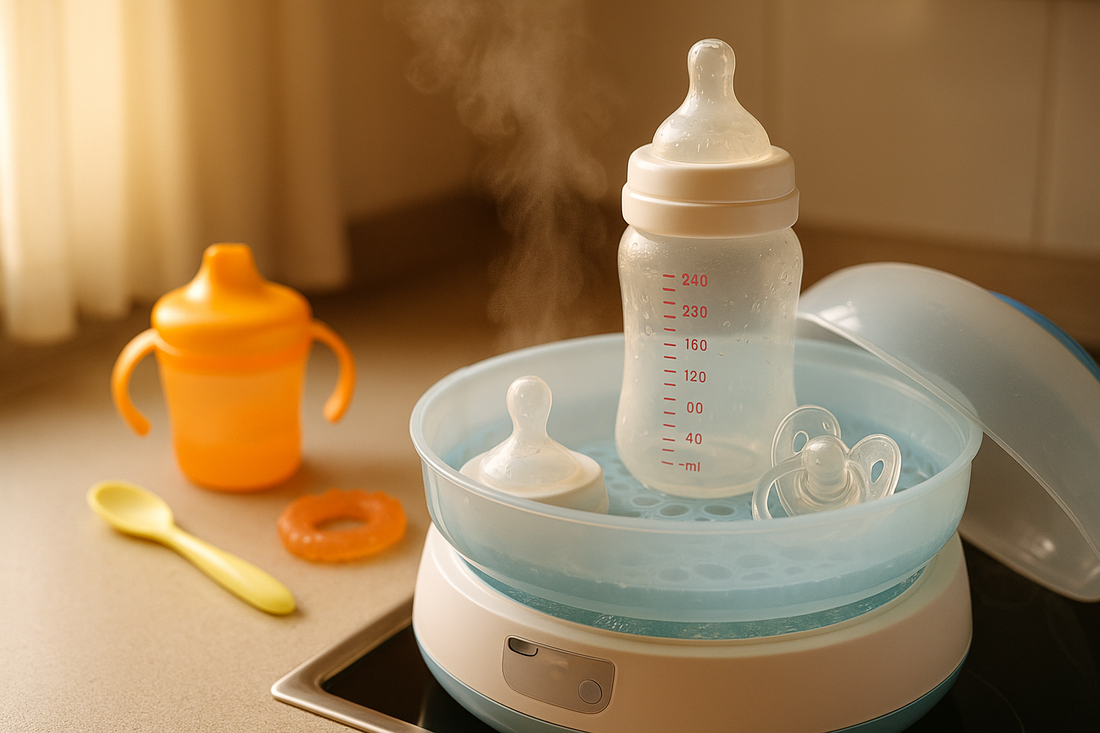
10 Baby Items You Must Sterilize Daily (Indian Parents’ Guide)
Share
Sterilizing baby items is one of the most important hygiene steps every parent in India should follow. From bottles, pacifiers, and silicone feeding spoons to breast pump parts, teethers, and sippers, knowing what baby items to sterilize daily keeps your newborn safe from harmful germs. This blog covers the most essential baby products you should sterilize regularly, how often to clean them, and the best sterilizing methods that suit Indian homes. Whether you’re a new parent or building your baby care routine, this hygiene checklist will help protect your little one’s health from day one.
Baby Hygiene 101: What You Really Need to Sterilize Every Day
When you become a parent, keeping your baby safe becomes your first instinct. But in the middle of feeding, crying, and diaper changes, one thing that often gets missed is sterilization. Just washing with soap and water isn’t enough—especially in Indian conditions where heat, humidity, and water quality can make germs grow faster.
Think of sterilization like this: if something goes into your baby’s mouth or touches milk, it needs a clean start. That’s where sterilizing becomes not just helpful—it becomes essential.
Let’s dive into the 10 most important baby items you should be sterilizing regularly, and how to do it right.
1. Feeding Bottles and Nipples
This one tops the list for a reason. Milk residue is a breeding ground for bacteria. Even after washing, traces can stick inside bottles or the base of nipples. Sterilize all feeding bottles and nipples after every use, especially during the first 6 months.
Most Indian parents prefer using silicone bottles over plastic. Silicone is safer, easier to clean, and doesn’t hold stains or odour. Sterilizing silicone bottles is quick and efficient using steam or boiling water.
Use Nibbles Multipurpose Bottle which will last longer, toxic free and easy to clean
2. Breast Pump Parts
If you’re using a breast pump, every part that touches milk or skin needs to be sterilized. That includes flanges, valves, connectors, and milk storage containers. Even a small drop of leftover milk can attract germs quickly in Indian weather.
Sterilize all pump parts after every pumping session.
3. Pacifiers and Soothers
These end up on the floor more than we like to admit. A pacifier may look clean, but invisible bacteria stick to it easily. If your baby uses a pacifier daily, sterilize it once every day and rinse it with hot water after every use. Always carry a spare one in a clean case when stepping out.
4. Teethers and Chew Toys
Once teething starts, everything goes straight to your baby’s mouth. Teething toys and rings attract dust, saliva, and food particles. Choose BPA-free silicone teethers since they are easier to sterilize and don’t degrade with repeated boiling.
Sterilize teethers at least once daily, or more often during summer.
Check out our Nibbles Dino Teethers
5. Silicone Feeding Spoons and Bowls
Feeding solids? Then every spoon, bowl, and food container should be sterilized at the end of the day. This includes soft-tipped spoons, silicone bowls, and even the baby’s food masher if you’re prepping at home. Silicone is again the preferred choice because it resists stains and can handle boiling heat.
6. Sippers and Transition Cups
Once your baby transitions from bottle to cup, don’t stop sterilizing. Sippers often come with hidden parts like valves and spouts where milk can get trapped. These should be taken apart and sterilized daily. Ensure they’re fully dry before reassembling to avoid mould.
7. Bottle Brushes and Cleaning Tools
Here’s what most parents miss: the brush or sponge used to clean bottles can get germy too. If you’re not sterilizing it, you're just transferring bacteria from one wash to another. Boil or steam-sterilize your bottle brush once a day.
You can try our Cleaning kit made out of Silicone Nibbles Baby Bottle Cleaner Kit
8. Baby Medicine Droppers and Nasal Syringes
Whether it’s for colic drops, vitamins, or saline water—anything you use to feed medicine should be sterilized. Clean and sterilize all parts, especially if they’re used during illness. Infection risk is higher when your baby is already sick.
9. Milk Storage Containers
If you pump and store milk, every container should be sterilized before use. Even if you store in sterilized breast milk bags, the funnel or surface the bag touches needs to be clean.
10. Silicone Bibs and Mats
Feeding mats and bibs may not seem as risky, but babies tend to chew on them during meals. Silicone bibs often fold or curl, which can trap food and bacteria. Wash after every meal and sterilize once a day for best safety.
How to Sterilize Baby Products at Home in India
You don’t need a fancy sterilizer to keep your baby safe. These methods work great:
- Boiling Water: Submerge items for 5–10 minutes. Ideal for silicone.
- Steam Sterilizers: Easy and fast. Great for everyday use.
- UV Sterilizers: Expensive but excellent for tech-savvy homes.
- Sterilizing Tablets: Handy while travelling or during water shortages.
Always dry sterilized items using a clean cloth or air-dry in a closed container.
How Often Should You Sterilize?
- Daily: Bottles, nipples, pump parts, pacifiers, spoons, sippers, teethers
- Weekly: Bibs, feeding mats, medicine droppers
- Immediately after illness: Sterilize all feeding tools and pacifiers if your baby is recovering from sickness.
Sterilization Tips for Indian Parents
- Use filtered or boiled water when rinsing sterilized items.
- Invest in silicone baby feeding products—they’re safer and last longer.
- Store sterilized items in an airtight, clean box to prevent recontamination.
- Avoid overusing harsh detergents—sterilization is more important than scent.
Key Takeaways
- Always sterilize baby bottles, nipples, teethers, and feeding tools.
- Use boiling, steaming, or UV methods for safe sterilization.
- Choose BPA-free silicone baby products for easier cleaning.
- Create a daily sterilizing routine to protect your baby’s health.
